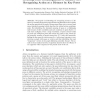Free Online Productivity Tools
i2Speak
i2Symbol
i2OCR
iTex2Img
iWeb2Print
iWeb2Shot
i2Type
iPdf2Split
iPdf2Merge
i2Bopomofo
i2Arabic
i2Style
i2Image
i2PDF
iLatex2Rtf
Sci2ools
ACCV
2010
Springer
2010
Springer
Modeling Sense Disambiguation of Human Pose: Recognizing Action at a Distance by Key Poses
Abstract. We propose a methodology for recognizing actions at a distance by watching the human poses and deriving descriptors that capture the motion patterns of the poses. Human poses often carry a strong visual sense (intended meaning) which describes the related action unambiguously. But identifying the intended meaning of poses is a challenging task because of their variability and such variations in poses lead to visual sense ambiguity. From a large vocabulary of poses (visual words) we prune out ambiguous poses and extract key poses (or key words) using centrality measure of graph connectivity [1]. Under this framework, finding the key poses for a given sense (i.e., action type) amounts to constructing a graph with poses as vertices and then identifying the most "important" vertices in the graph (following centrality theory). The results on four standard activity recognition datasets show the efficacy of our approach when compared to the present state of the art.
| Added | 12 May 2011 |
| Updated | 12 May 2011 |
| Type | Journal |
| Year | 2010 |
| Where | ACCV |
| Authors | Snehasis Mukherjee, Sujoy Kumar Biswas, Dipti Prasad Mukherjee |
Comments (0)

